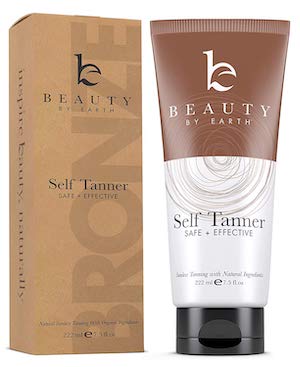While sunbathing is the traditional, most popular way to achieve sun-kissed skin, self-tanning products are becoming a hit too. They are cost-effective and save you from harmful sun rays. Are they really safe? What are their ingredients? Find out how do self-tanners work before using them.
So how do self-tanners work? Self-tanners work by creating a reaction with the active ingredient DHA within dead skin cells that causes a temporary tan to occur.
Sound confusing? Keep reading to learn more.
How do self-tanners work?
Self-tanners, or sunless tanning products, are sold as different products: lotions, sprays, and creams. Pills and professional spray-on are also available.
Examples of self-tanning products are Body Drench Quick Tan Spray and Beauty by Earth Self-Tanner (my personal favorite).
Human skin is made up of two main layers—the epidermis which is the outer layer and the dermis which is the inner layer. It is in the epidermis where tanning happens.
It is further divided into layers—the stratum basale is the deepest layer which is affected during sunbathing, and the stratum corneum is the outermost layer that is affected by self-tanning products.
The skin is made up of millions of dead skin cells. This is where the self-tanning products take action. The active ingredient is the dihydroxyacetone (DHA) which responds to the dead skin cells that causes a temporary dark skin or tan.
Since these dead skin cells usually slough off every 35 to 45 days, the tan gradually fades as the dead skin cells fall off. Reapplication of self-tanning products is recommended every 3-4 days to keep the tan.
Ingredients of different self-tanning products
Although DHA is said to be the most effective, safest ingredient, different self-tanning products contain other active ingredients.
- Self-tanning lotions and pills contain the amino acid tyrosine that enhances and increases the formation of melanin, hence, hastening the tanning process. Although many products claim this theory, it is not yet supported by scientific data
- Self-tanning pills also have canthaxanthin, which is usually found in many food color additives. Although it is FDA approved as a food additive, it is not approved as a color additive. When taken as a self-tanning pill, the canthaxanthin goes to the different parts of the body. It makes the skin orange-brown in color. However, this ingredient may cause side effects such as hepatitis and eye problem
- Skin bronzers are makeup products which create a tan which is easily removed with soap and water
- Self-tanning products usually do not contain sunscreen. Some self-tanners do, but it is only good for a few hours. Apply sunscreen if you plan to go out under the sun to protect your skin.
Caution in applying self-tanners
Dihydroxyacetone is approved by the FDA as a skin product; it is non-toxic and non-carcinogenic. Many dermatologists consider it safer than getting a tan under the harmful UV rays. However, this active ingredient should not be inhaled or applied to mucous membranes.
Strictly follow the application instructions stated on the label. Avoid getting the self-tanner in the eyes, nose, lips, and ears. You might need to wear a mask, apply lip balm, or wear a nose filter during application.
How do you apply self-tanning lotion?
To ensure a safe and effective application, here are some ways to apply self-tanners:
- Exfoliate the skin, especially the knees, elbows, and ankles, before applying self-tanners. Doing so will help remove extra dead skin cells. Dry the skin after exfoliating
- Apply the self-tanner in a circular motion. Do it on the different body sections like the torso, arms, and legs. Apply it slightly from the ankles to the feet and from the wrists to the hands. Wash your hands after every application of the product to each body section
- Go easy on the joint areas. These areas quickly absorb the self-tanner which may cause extra tanning. To lessen the tanning effect on these areas, gently wipe them off with a damp towel
- When the application is done, wait for at least 10 minutes for the product to dry. Avoid wearing tight clothes and try to prevent sweating
Conclusion
Self-tanning products are a great alternative to sunbathing. It saves you from harmful UV rays which might damage your skin.
However, it is important to understand how self-tanners work, the active ingredients of each self-tanning product and the proper application ensure safe and effective tanning.

